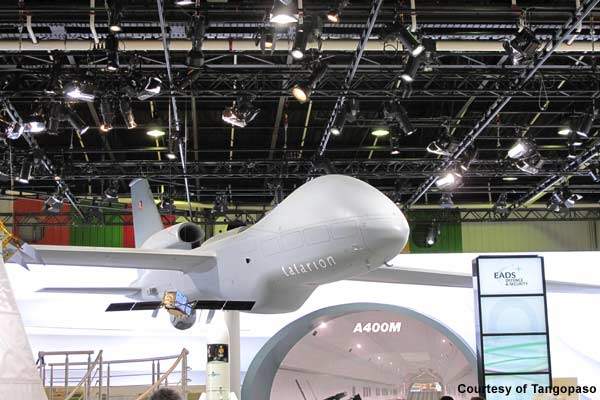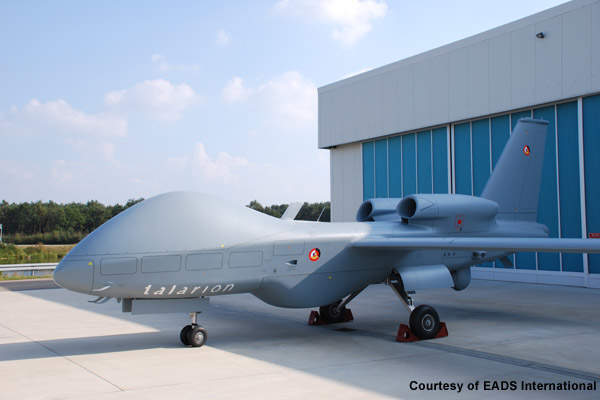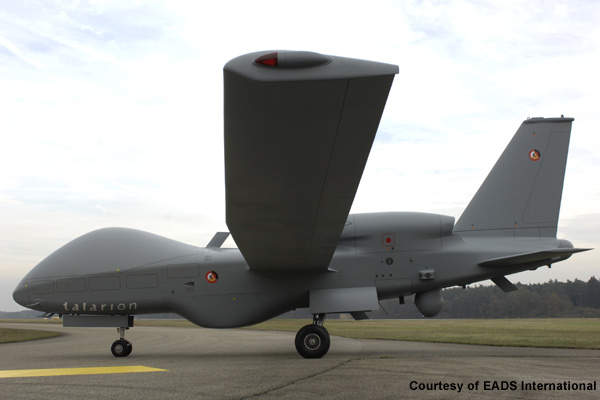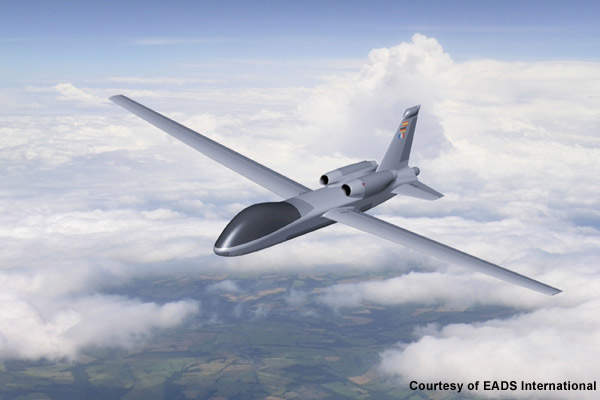Talarion is a medium altitude long endurance (MALE) unmanned air vehicle (UAV) designed and manufactured by European Aeronautic Defence Space (EADS) for France, Germany and Spain.
The twin-jet engine UAV will be principally used to perform intelligence, surveillance, target acquisition and reconnaissance (ISTAR) operations. It will also perform land, sea and littoral environment missions. The maiden flight of Talarion is planned for 2013 and it will enter into service in 2016.
The UAV will also offer fully automated take-off and landing capabilities even in adverse weather conditions. It will provide its operators with real-time information on the enemy’s battlefield by performing surveillance and target acquisition over a large area.
The aircraft can fly at high altitudes in operation areas for long durations and is less sensitive to high-wind speed.
France and Germany will each receive six unmanned aerial systems (UAS) along with 18 unmanned air vehicles, while Spain will acquire three systems, including nine UAVs in 2015. Each UAS of the Talarion will comprise three Talarion vehicles and a ground control station (GCS) to monitor and evaluate the data.
Talarion UAV design
Talarion has been designed to tailor certification-emerging standards. The unique design of the aircraft will ensure broader government security operations compared to existing UAVs and its derivatives. The modular design of the aircraft allows it to operate in different configurations.
MALE UAV aircraft development
In December 2007, EADS was awarded a 15-month risk reduction contract by the defence ministries of France, Germany and Spain. The contract lasted for two years, that is, until 2009. The close discussions between the three nations and their respective air forces led to the development of an advanced UAV (A-UAV) system solution or the Talarion UAV.
The final evaluation and budget planning for the development of the aircraft began in April 2009.
A mock-up of the Talarion was showcased in the Paris Air Show in June 2009. In December 2011, EADS signed an MoU with Alenia Aeronautica for the development of the next-generation Talarion UAV system.
Talarion aircraft navigation
The Talarion can be controlled either manually from the GCS or through an autonomous mode using automatic launch and recovery (ALR) system. The UAV will land safely in spite of communication error in the GCS.
UAV sensors and radars
The Talarion UAV will be equipped with electro optic (EO) and infrared (IR) sensors, and a laser designator. The EO sensor will convert light rays into electronic signals for capturing images, real-time data and videos while the laser designator targets the enemy’s battlefield.
A synthetic aperture radar (SAR), active electronically scanned array (AESA) radar, signal intelligence (SIGINT) and electronic support measures (ESM) are incorporated in the fuselage section of the aircraft.
The SIGINT is used to search, analyse and jam all communication signals. The aircraft performs ground and maritime surveillance with a single GMTI radar.
UAV aircraft engine
The UAV is powered by two jet engines. The twin-jet engines will provide sufficient energy to the sensors and payload communication subsystems for completing the aircraft’s mission. These engines will also protect the UAV in the densely populated air traffic over Europe.
In case of engine failure, the second engine will help the aircraft to either complete its mission or ensure the safe return to the base.
Talarion UAV performance
The Talarion can fly at a maximum speed of 555km/h. The altitude of the aircraft varies between 3,048m and 15,240m. The maximum endurance of the aircraft is 20h. The maximum take-off weight is 7,000kg and its maximum payload is 800kg.
Talarion ground control station
Talarion UAV’s GCS will be manufactured by EADS Defence and Security. The data retrieved and transmitted by the UAV will be stored at the GCS. The control station will feature a ground data terminal, a remote video terminal and a flight line tester / loader. An air data computer in the GCS will display the UAV’s position.






